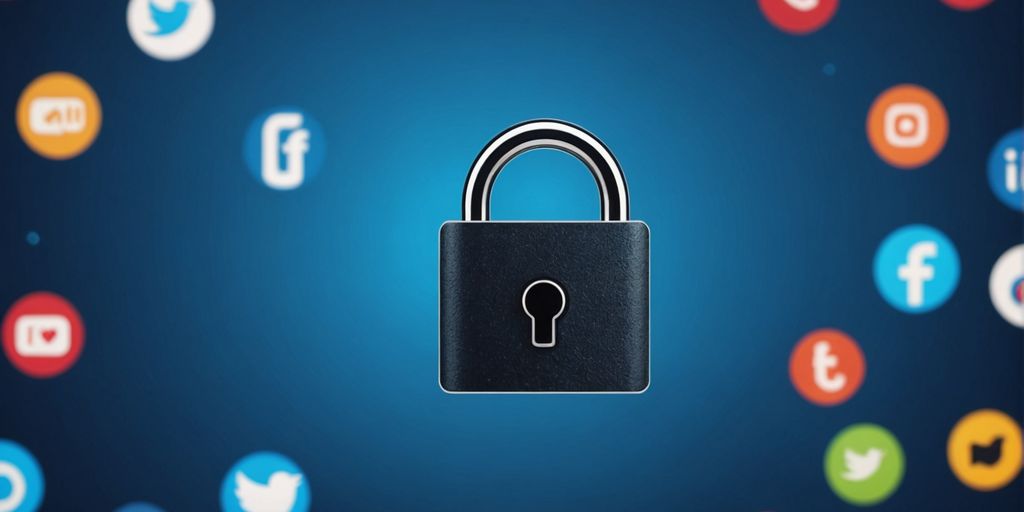In today’s digital age, social media platforms have become a significant part of our lives. While these platforms offer great ways to connect and share, they also come with privacy risks. Understanding and managing your privacy settings is crucial to protect your personal information and maintain control over who sees what you share.
Key Takeaways
- Privacy settings help you control who can see your posts and personal information.
- Different social media platforms have unique privacy options and settings.
- Regularly reviewing and updating your privacy settings can enhance your online security.
- Ignoring privacy settings can lead to unwanted data exposure and targeted advertising.
- Using additional tools and resources can further improve your social media privacy.
Understanding Social Media Privacy Settings
Social media privacy settings help users manage their online presence and protect personal information. These settings are crucial for maintaining control over who can see your posts and data. Before making any changes, take stock of your privacy settings on each social media platform. This includes Facebook, Instagram, Twitter, LinkedIn, and others.
Facebook Privacy Settings
Adjusting Profile Visibility
By default, your profile might be pretty open, with lots of your information available for anyone to see, but with a few quick adjustments, you can tighten your personal security. Click on the little arrow in the upper-right corner to access your “Account.” There is a “Settings and Privacy” tab in the dropdown menu. From there, you can control who sees your profile and posts.
Managing Friend Lists
To manage your friend lists, go to your profile and click on the “Friends” tab. Here, you can create custom lists to organize your friends. This allows you to share posts with specific groups of people. For example, you might have a list for family and another for coworkers. This way, you can control who sees what you share.
Controlling Post Visibility
On a computer: Click your profile picture in the top right of the Facebook home page > Settings & privacy > Settings > Privacy > Who can see your future posts? > Edit. Select “Friends” or another group you may have set up. Then on the same page, click “Limit the audience for posts you’ve shared with friends of friends or Public?” Select “Limit Past Posts.”
These controls and techniques give users a measure of control over how Facebook collects and uses personal data. It’s important for users who care about their privacy to understand the available settings—even if these controls don’t offer all the protections you might want.
Twitter Privacy Settings
Protecting Your Tweets
To keep your tweets private, you can make your account private. This means only your followers can see your tweets. To do this, go to "Settings and Privacy," then "Privacy and Safety," and finally, toggle the "Protect your Tweets" option. This is a great way to take control of your Twitter privacy settings and keep your personal information secure.
Managing Followers
Managing your followers is crucial for maintaining privacy. You can remove followers by going to your profile, clicking on "Followers," and then selecting the three dots next to the follower you want to remove. This will give you the option to remove them from your list. This step-by-step guide ensures you have control over who can see your content.
Controlling Tagging and Mentions
You can control who can tag you in photos and mention you in tweets. Go to "Settings and Privacy," then "Privacy and Safety," and look for the "Photo tagging" and "Mentions" options. Here, you can choose to allow anyone, only people you follow, or no one to tag or mention you. This helps in avoiding unwanted data exposure and keeps your interactions more private.
Instagram Privacy Settings
Setting Your Account to Private
One of the first steps to securing your Instagram account is to set it to private. This means only people you approve can see your posts and stories. This is a simple yet effective way to control who views your content. To do this, go to your profile, tap the menu icon, select ‘Settings,’ then ‘Privacy,’ and toggle the ‘Private Account’ option.
Managing Story Visibility
Instagram allows you to control who can see your stories. You can hide your stories from specific people or create a ‘Close Friends’ list to share stories with a select group. This feature is useful for sharing moments with a smaller, more trusted audience.
Controlling Comments and Tags
To manage comments and tags, go to ‘Settings,’ then ‘Privacy,’ and select ‘Comments’ or ‘Tags.’ Here, you can block comments from certain users and approve tags before they appear on your profile. This helps in maintaining a positive and controlled environment on your account.
LinkedIn Privacy Settings
LinkedIn offers a variety of privacy settings to help you control who can see your information and activity. Understanding these settings is crucial for maintaining your privacy and security on the platform.
Snapchat Privacy Settings
Snapchat allows you to control who can contact you through the app. By adjusting these settings, you can limit interactions to only your friends or allow everyone to reach out. To change these settings, open Snapchat, navigate to your profile, and tap the settings gear at the top right. From there, look for the ‘Who Can…’ section and make your selections.
You can decide who gets to see your Snapchat stories. This is crucial for maintaining your privacy. Go to the settings menu and find the ‘View My Story’ option. Here, you can choose between ‘Everyone,’ ‘My Friends,’ or ‘Custom’ to select specific friends. This way, you can share moments only with those you trust.
Snapchat’s Snap Map feature lets you share your location with friends. However, you can control who sees your location or turn it off entirely. To adjust this, go to the settings menu and find ‘See My Location.’ You can choose ‘Ghost Mode’ to hide your location, or select specific friends who can see where you are. This feature is essential for ensuring safety and privacy.
TikTok Privacy Settings
Setting Your Account to Private
To make your TikTok account private, go to your profile and click on the “Settings” tab. In the “Privacy” section, you can choose the “Private Account” option. This means you must approve someone before they can watch any of your videos. This simple step can significantly enhance your privacy on the platform.
Managing Followers
Managing your followers on TikTok is straightforward. You can approve or deny follow requests, ensuring that only people you trust can see your content. This is especially important for younger users, as TikTok updated its privacy settings in January 2021 to make accounts for users under 16 private by default. This means other users must be approved before they can follow or interact with these accounts.
Controlling Comments and Duets
TikTok allows you to control who can comment on your videos and who can create duets with your content. You can set these options to “Everyone,” “Friends,” or “No one.” This feature is particularly useful for avoiding unwanted interactions and maintaining a safe online environment. For parents, TikTok offers a feature that allows them to link to their teenager’s account and control content and privacy settings, providing an extra layer of security.
Privacy Settings for Lesser-Known Platforms
When it comes to social media, privacy settings are crucial, even on lesser-known platforms. These settings help users control who can see their information and how they interact with others. Let’s explore the privacy settings for Reddit, Pinterest, and Clubhouse.
The Risks of Ignoring Privacy Settings
Unwanted Data Exposure
Ignoring privacy settings can lead to unintended exposure of personal data. When users don’t adjust their settings, their information might be visible to the public, including people they don’t know. This can result in security issues like phishing, information leaks, and stalking.
Targeted Advertising
Social media platforms often use your data for targeted advertising. If you don’t manage your privacy settings, you might find yourself bombarded with ads that feel intrusive. This happens because platforms monitor your interactions and preferences to tailor ads specifically to you.
Social Engineering Risks
Social engineering is a tactic used by cybercriminals to manipulate people into revealing confidential information. When privacy settings are neglected, it becomes easier for these criminals to gather personal details and use them for malicious purposes. This can range from minor annoyances like spam to serious threats like identity theft.
Best Practices for Social Media Privacy
Regularly Reviewing Settings
It’s important to regularly review your privacy settings on all social media platforms. This ensures that your information remains protected as platforms update their features. Make it a habit to check your settings every few months.
Using Two-Factor Authentication
Two-factor authentication (2FA) adds an extra layer of security to your accounts. By requiring a second form of verification, such as a text message or authentication app, you can significantly reduce the risk of unauthorized access.
Being Mindful of Shared Information
Be cautious about the information you share online. Avoid posting and sharing information about your physical location on social media. This includes your address, photos of the outside of your home, and other personal details that could be used to identify you.
Implementing Strong Passwords
Use strong, unique passwords for each of your social media accounts. A strong password typically includes a mix of letters, numbers, and special characters. Avoid using easily guessable information like birthdays or common words.
Educating Yourself and Others
Stay informed about the latest social media security risks and best practices. Share this knowledge with friends and family to help them protect their accounts as well. Education and awareness are key to maintaining a secure online presence.
Tools and Resources for Enhanced Privacy
Third-Party Privacy Tools
To boost your privacy on social media, consider using third-party tools. These tools can help you manage your settings more effectively and provide additional layers of security. For instance, some tools allow you to download the content and privacy settings of your account, which is one of the best ways to preserve evidence of abuse.
Educational Resources
Understanding privacy settings can be complex. Thankfully, there are many educational resources available to help you. These resources often explore privacy-enhancing technologies like cryptographic algorithms and data masking. They can guide you through the landscape of privacy tools and show you how to use them effectively.
Platform-Specific Guides
Each social media platform has its own set of privacy settings. Platform-specific guides can be incredibly useful in navigating these settings. They provide step-by-step instructions on how to adjust your privacy settings to better protect your data. For example, some guides offer tips on how to develop a strong password policy and enable two-factor authentication.
By using these tools and resources, you can take control of your online privacy and protect your personal information from unwanted exposure.
Conclusion
In today’s digital age, understanding and managing your social media privacy settings is more important than ever. While platforms like Facebook, Twitter, and Instagram offer various tools to help protect your personal information, it’s up to you to use them effectively. By taking the time to adjust your settings, you can control who sees your posts, limit unwanted ads, and keep your data safe from prying eyes. Remember, staying informed and proactive is key to maintaining your privacy online. So, take charge of your digital footprint and make sure your social media presence is as secure as possible.


